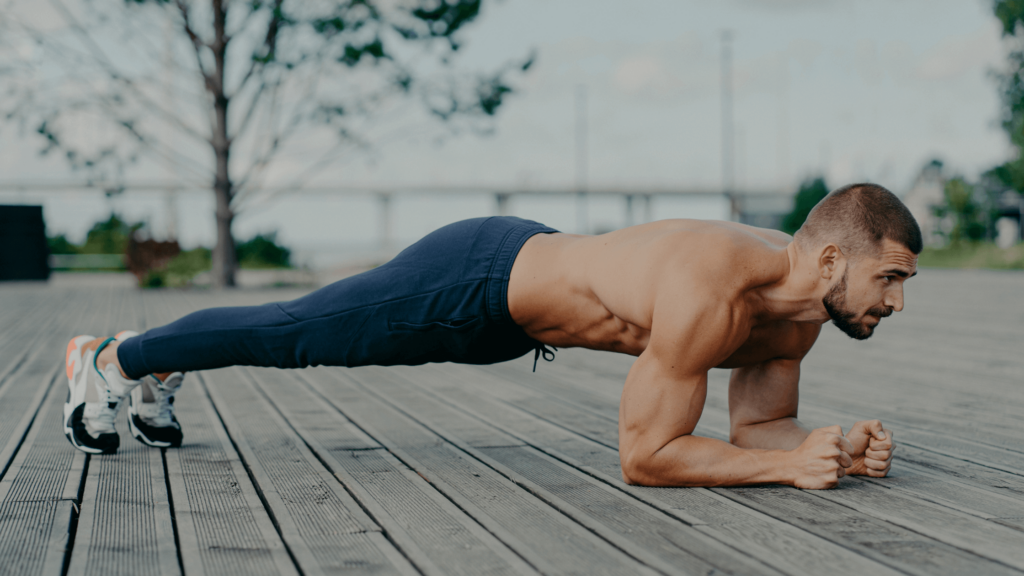For construction workers, physical activity is a daily occurrence. Whether lifting heavy objects from the ground, hammering a nail into a frame, or using an impact gun above your head, there is always an activity that puts strain on your body. Over time, this strain can take a toll, especially if your core is weak. Performing simple core exercises like the farmers carry and hollow hold just once a week can help you move easily and prevent injury, keeping you safe on the job.
Quick look
- The core is more than just the “six-pack” abs; it involves muscles from your abdominal region, back, pelvic floor, diaphragm, and hips.
- Construction workers rely on their core strength to stay stable, balanced, and safe on the job, especially when lifting, bending, or working in awkward positions.
- A strong core helps prevent injuries, improve posture, and absorb shock, reducing the strain on joints and muscles during physical tasks.
- Key exercises, such as the farmer carry and hollow hold, can be easily incorporated into your routine to boost core stability and prevent back pain.
Core anatomy—it’s not just abs

When it comes to the core, most people associate the “six-pack” with your core muscles. However, this group of abdominal muscles are just a small piece of the puzzle. Other muscles like your pelvic, back, and hip muscles are also part of your core, helping to stabilize the spine while it moves.
Here is a list breaking down each muscle group, the muscles involved, and what they do:
Abdominal muscles
- Rectus abdominis: Flexes the spine and supports posture.
- External obliques: Rotate and stabilize the torso.
- Internal obliques: Assist in rotation and lateral flexion to stabilize the trunk.
- Transverse abdominis: Deep muscle that stabilizes the spine and pelvis.
Back muscles
- Erector spinae: Extends and stabilizes the spine.
- Multifidus: Stabilizes individual vertebrae.
- Latissimus dorsi: Stabilizes the trunk during movement.
Diaphragm
- Supports core stability by increasing intra-abdominal pressure during breathing.
Pelvic muscles
- Pelvic floor muscles: Stabilize the pelvis.
- Iliopsoas: Stabilizes the lumbar spine and pelvis.
Hip muscles
- Hip flexors (iliacus, psoas major): Stabilize the lower spine and pelvis.
- Gluteus maximus: Stabilizes the pelvis and maintains posture.
- Hip abductors: Stabilize the pelvis and support spinal alignment.
This list may sound exhausting, but with the right core routine, you can easily target most of these muscles within a short timeframe.
Why core strength matters in the building industry
Core strength is essential in the building industry because it helps you stay stable, balanced, and safe while performing your tasks. Many jobs in construction involve lifting heavy materials, bending, twisting, or working in awkward positions. A strong core will support the spine and prevent injuries, such as lower back pain or strains. It helps in several areas to accomplish this:
- Shock absorption: The core acts like a cushion for the body. When workers walk on hard surfaces or carry heavy loads, a strong core absorbs some of the impact, reducing stress on joints and bones.
- Posture: Core strength helps workers stand and move correctly, preventing slouching or leaning. Good posture is key to avoiding muscle fatigue and long-term injuries, especially during tasks that involve lifting or staying in one position for a long time.
- Balance: Many jobs in construction require working on ladders, scaffolding, or uneven surfaces. A strong core improves balance, helping workers stay steady and preventing falls or accidents.
- Injury prevention: A strong core helps support the spine, reducing the risk of injury while lifting, bending, or carrying heavy materials. It keeps the body aligned, making it easier to maintain proper posture and avoid strain on the back.
- Muscular coordination and efficiency: A strong core helps muscles work together smoothly, making movements more efficient. This means less energy is wasted, and tasks can be completed faster and with less effort.
- Breath control: A strong core helps with proper breathing, allowing you to take deeper, more controlled breaths. This is especially useful during physical activities or heavy lifting, as it improves stamina and reduces fatigue.
- Agility: Core strength improves your ability to move quickly and change direction with control. It helps you perform tasks that require fast movements, like dodging obstacles or shifting weight quickly.
The top 10 core exercises to practice daily

1. Back extensions
Difficulty: Medium
How to do it: Lie face down on a mat or back extension machine with your hips supported. Keep your hands behind your head or crossed over your chest. Slowly lift your upper body off the ground, extending your back, and then lower back down with control.
Muscles targeted: Lower back (erector spinae), glutes, hamstrings
Benefits: Improves spinal stability, reducing the risk of back injuries
2. Hollow hold
Difficulty: Medium to hard
How to do it: Lie on your back with your arms extended above your head. Lift your legs and shoulders off the ground, pressing your lower back into the floor while engaging the rectus abdominis. Hold the position for up to 60 seconds, keeping your body in a slight “C” shape. To make it easier, you can move your arms in front of you instead of behind your head.
Muscles targeted: Abdominal muscles, hip flexors
Benefits: Builds flexion strength and endurance, improving stability and control when bending
3. Plank & variations (side plank)
Difficulty: Medium
How to do it: For a standard plank, hold a push-up position with your body in a straight line, engaging your core. For side planks, lie on your side, supporting your body on one forearm, keeping your body in a straight line. Hold each for 30 to 60 seconds.
Muscles targeted: Rectus abdominis, obliques, lower back
Benefits: Strengthens the entire core
4. Glute bridge
Difficulty: Easy
How to do it: Lie on your back with your knees bent and feet flat on the floor. Lift your hips towards the ceiling by squeezing your glutes and engaging your core, then lower your hips back down.
Muscles targeted: Glutes, hamstrings, lower back, core
Benefits: Stabilizes the pelvis
5. Deadbug
Difficulty: Medium
How to do it: Lie on your back with your arms extended towards the ceiling and knees bent at 90 degrees. Slowly lower your right arm and left leg towards the floor while pressing your lower back into the ground. Return to the starting position and switch sides.
Muscles targeted: Rectus abdominis, obliques, hip flexors
Benefits: Improves coordination and stability of the spine by strengthening the deep core muscles
6. Bird-dog
Difficulty: Medium
How to do it: Start on all fours with your hands directly under your shoulders and knees under your hips. Extend your right arm and left leg simultaneously, keeping your body stable. Return to the starting position and repeat on the opposite side.
Muscles targeted: Core, glutes, lower back, shoulders
Benefits: Enhances balance, coordination, and stability
7. Bent knee windshield wipers
Difficulty: Medium
How to do it: Lie on your back with your arms out to the sides for support and your knees bent at 90 degrees. Slowly lower your knees to one side while keeping your shoulders on the floor, then bring them back to the center and lower to the other side.
Muscles targeted: Obliques, lower abdominals
Benefits: Improves rotational strength
8. Pallof press with band
Difficulty: Medium
How to do it: Attach a resistance band to a stationary object at chest height. Stand sideways to the band with your hands holding the band in front of your chest. Step back to create tension, then push the band straight out from your chest, resisting the pull.
Muscles targeted: Rectus abdominis & obliques
Benefits: Improves anti-rotational stability
9. Farmer’s carry
Difficulty: Medium to hard
How to do it: Hold a heavy dumbbell or kettlebell in each hand, keeping your back straight and core engaged. Walk a set distance while maintaining an upright posture.
Muscles targeted: Core, shoulders, forearms, lower back
Benefits: Builds lateral core stability and grip strength
10. Renegade row
Difficulty: Hard
How to do it: Start in a high plank position with a dumbbell in each hand and wrists directly under your shoulders. Keeping your body in a straight line, engage your core and row one dumbbell towards your torso while stabilizing your body with the other arm. Lower the dumbbell back down and repeat on the other side.
Muscles targeted: Entire core, back (lats, rhomboids), shoulders, arms
Benefits: Strengthens the stabilizing muscles, improving balance, coordination, and anti-rotational strength
Routine instructions:
- Frequency: Aim to perform 2-3 sets of each exercise, holding for 20-60 seconds for holds (like plank variations) or completing 8-12 reps for dynamic movements (like bird-dog or deadbug).
- Form: Proper form is crucial for avoiding injury. If an exercise feels too difficult, modify it by reducing the range of motion or holding for a shorter duration, then gradually increase as your strength improves.
Bottom line
A strong core is essential for both daily activities and physical tasks, especially in the building and trade industries. The exercises listed are simple yet effective ways to strengthen and stabilize your core, improve posture, reduce pain, and prevent injuries. Incorporating these movements into your routine just once a week can help you stay safe and perform at your best on the job.
Ready to take your fitness to the next level? Subscribe to our newsletter and follow us on social media for more tips, workout routines, and expert advice to help you stay strong and injury-free.




1 comment